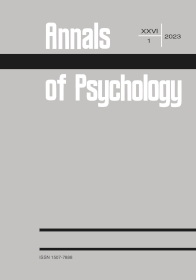DIMENSIONS OF TEMPERAMENT IN ADULTS WITH CHRONIC STUTTERING IN THE LIGHT
OF I. P. PAVLOV’S THEORIESa*
DIMENSIONS OF TEMPERAMENT IN ADULTS WITH CHRONIC STUTTERING IN THE LIGHT
OF I. P. PAVLOV’S THEORIESa*
Author(s): Ewa Humeniuk, Zbigniew TarkowskiSubject(s): Cognitive Psychology, Clinical psychology, Health and medicine and law
Published by: Towarzystwo Naukowe KUL & Katolicki Uniwersytet Lubelski Jana Pawła II
Keywords: temperament; Pavlov; chronic stuttering; adults;
Summary/Abstract: The aim of the study was to determine dimensions of temperament in adults with chronic stuttering in the light of Pavlov’s temperament typology. The test sample consists of a (1) clinical group— adults with chronic stuttering (N = 202); and (2) a criterion group—adults with normal speech fluency (N = 198). The Pavlovian Temperament Survey (PTS) by Strelau and Zawadzki and our own survey were administered. Stutterers, compared to subjects with normal speech fluency, are characterized by a lower level of the excitation process, mobility and balance of nervous processes; they also tend to exhibit a higher level of the inhibition process. The severity of stuttering, the age at which the first symptoms of speech disfluency occur, treatment, evaluation of its effectiveness and intention to undergo therapy do not differentiate stutterers in terms of the considered temperament traits. The temperamental factors of chronic stuttering as per Pavlov’s typology are: increased reactivity to stimuli, reduced ability to adapt to new situations, the ability to flexibly respond to changing conditions, a weak type of the nervous system (lower strength of the excitation process, weaker mobility of the nervous processes), which makes it difficult to cope with challenges encountered and increases susceptibility to mental disorders.
Journal: Roczniki Psychologiczne
- Issue Year: 26/2023
- Issue No: 1
- Page Range: 5-21
- Page Count: 17
- Language: English

